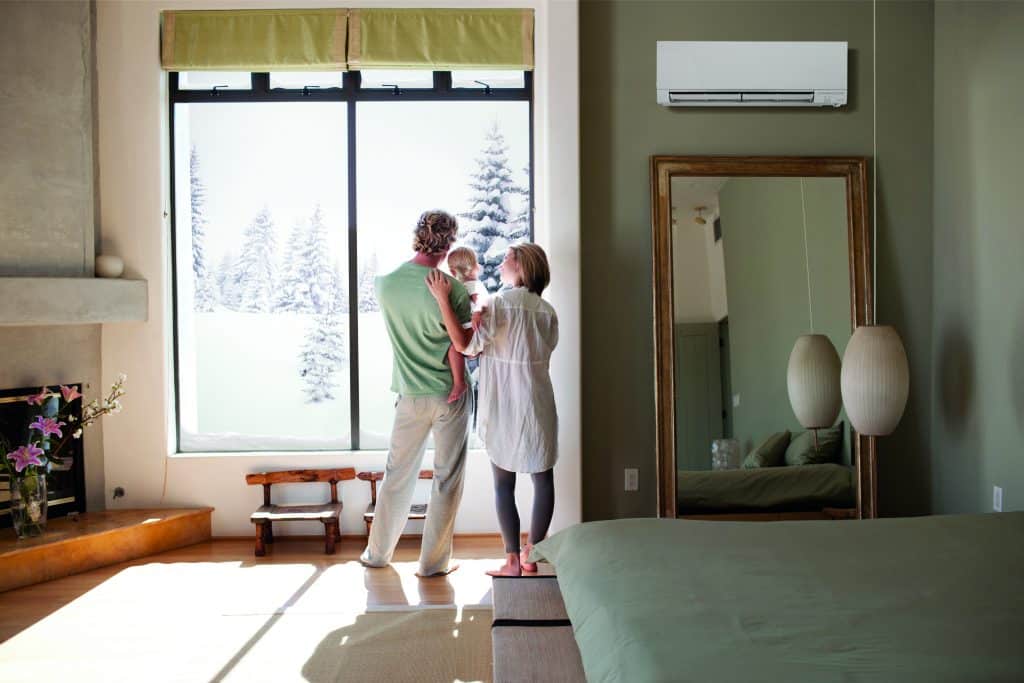In the past, when you were getting a new heating system, you often had to make your choice based on the availability of natural gas, propane, firewood, or electricity in your area. Now, technology has marched on, and you get to consider a lot more than just the fuel source when choosing your heating method. Two of the options you may want to consider are ductless heat pumps and baseboard heating.
Baseboard heating has been around for decades in the United States, and although heat pumps are just becoming popular in the U.S. market, they’ve been the go-to standard in Asia and Europe for many years. Here’s what you need to take into account when comparing these two options.

Heat Pump Essentials
Like refrigerators and air-conditioning units, a heat pump uses refrigerant to move heat from one place to another, and most of these units are reversible. During the winter, they capture heat from the outside air, compress it, and move it inside the house. During the summer, they move heat from inside the home to the outdoors.
Heat pumps were quite expensive when they first arrived on the market, but the prices have become much more affordable as the systems have been perfected. They are usually powered by electricity, but natural gas models are also available. Because heat pumps do not require ducts, they are also called ductless heaters, and they are extremely energy efficient and very quiet. These are the two main designs:
- Ground-Loop Geothermal Systems: Initially, these were the most popular heat pumps. They used pipes that looped through the ground and extracted heat from the earth. Many people still turn to these systems when they went in-ground heating.
- Mini-Split Systems: Mini splits are extremely versatile ductless systems that absorb heat from the air. These systems consist of a small, wall-mounted indoor air handling unit and an outside compressor. These units are connected by tubing that runs through a very small hole in the wall. This creates less air leakage than you get with most baseboard heaters.
Baseboard Heating Basics
Baseboard heaters are usually installed beneath windows so the rising warm air from the heater will counteract the cold air coming through the window. They must be properly fitted with the wall, or there can be considerable loss of air, making this a potentially expensive way to heat a home. There are two main types of baseboard heaters:
- Electric: The most popular baseboard heaters are electric. These systems house their heating elements in metal pipes, and each baseboard heater is paired with its own thermostat.
- Hot Water: There are also hydronic or hot water baseboard heaters. These radiant heat systems use a centralized boiler to heat water. Then, the water circulates through a system of pipes to the baseboard radiators. These systems are very durable and require very little maintenance, but they are slow to heat up. Depending on the system you select, they can be fueled by natural gas, propane, oil, or electricity.
Baseboard Heat Pros and Cons
When deciding between baseboard heaters and ductless systems, remember that baseboard heaters are hot to the touch. That can present a danger for children or pets, and they also impact furniture and curtain placement. Most importantly, you need to be sure that you never drop or leave anything on these radiators, lest it become a fire hazard. Beyond that, here is a brief look at some of the pros and cons of baseboard heating:
Advantages:
- Energy efficient
- Usually quiet with no fans or blowers
- Durable
- Require very little maintenance
It’s important to note that although electric baseboard heaters are quiet, radiator baseboard heaters can be noisy as the water and air moves through them.
Disadvantages
- Require unobstructed placement
- Need proximity to a window to work properly
- Often run the length of a wall, creating challenges with furniture placement
- Slow to heat
- Poor at regulating temperatures in areas such as basements and attics
- Cannot be reversed to provide cooling
- Create a dry heat which can lead to dry throats, itchy eyes, and even bloody noses
- After periods of disuse, may emit a burning smell caused by the accumulation of dust within the unit
Ductless Heating Pros and Cons
According to the U.S. Department of Energy, moving heat, rather than generating heat means heat pumps can provide up to four times the amount of energy they consume in electricity. Additionally, because there is no combustion (which is the process that makes heat in many conventional heating systems), there are no indoor pollutants such as carbon monoxide. Here’s a closer look at the pros and cons.
Advantages
- Offers both heating and cooling in a single unit
- Uses about 50% less electricity than baseboard heaters
- Doesn’t require placement near windows
- Provides fast, even heat
- Zone technology provides precise temperature control for every room of your home
- Fans are much quieter than those used in forced-air systems
- Two-speed compressors offer even more savings and less wear and tear on the compressor
- Individual rooms can be turned on or off to meet your heating or cooling needs
- Available in various sizes to match your home’s heating and cooling load
- Single outdoor condenser can support up to four individual room units
Disadvantages
- Costs more upfront but helps to save money and energy in the long run
- Requires you to clean the filters once a month
As you can see, there are many advantages to choosing a ductless heating system. They are less expensive than adding ductwork to an existing home, and they offer key advantages over baseboard heating. To learn more or to get a quote, contact us today. At N.E.T.R, we have been providing ductless heating and cooling systems to homes and businesses in the Boston area for years, and we would love to help you make your home more comfortable and more efficient.

